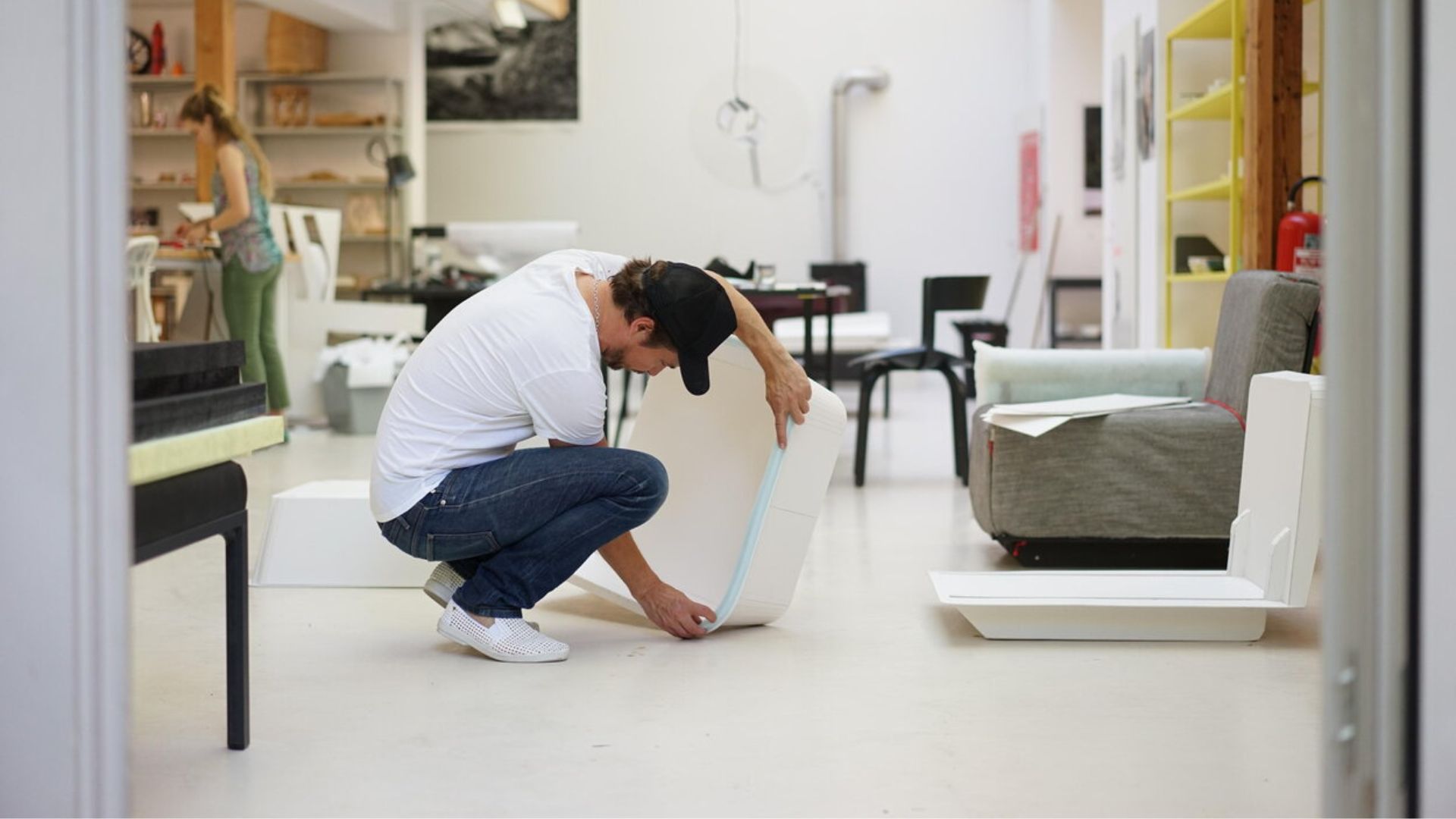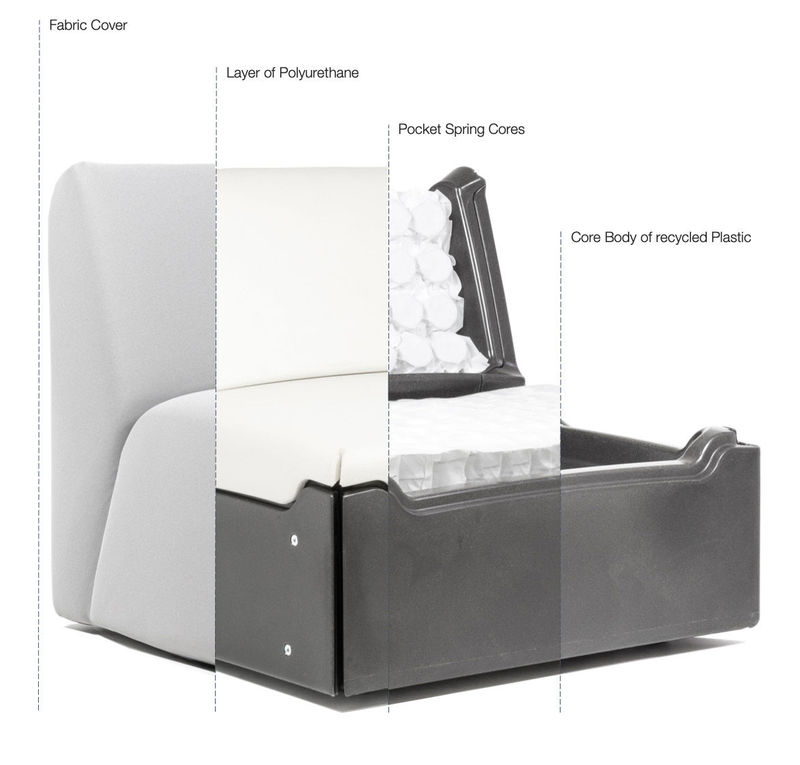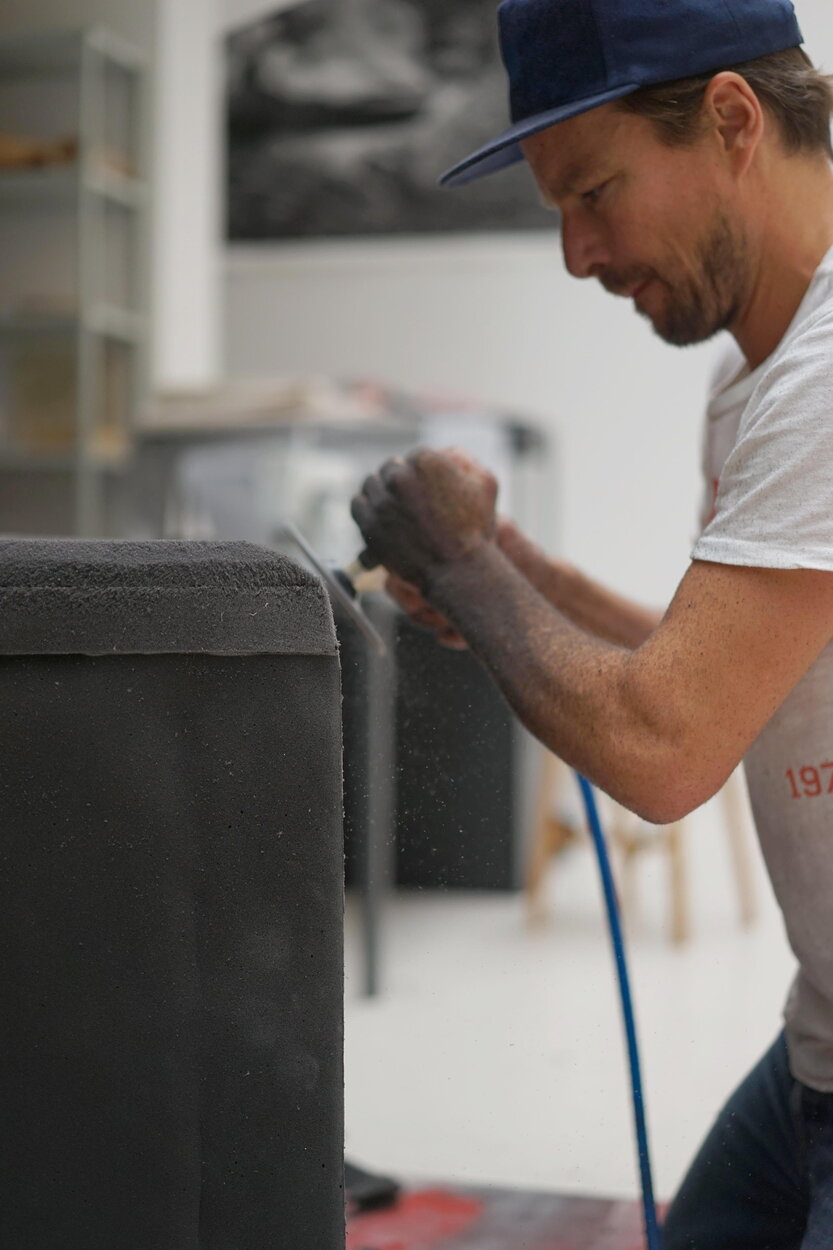The challenges of designing a product and a business model for sustainability
KEY TAKEAWAY:
The key to sustainability, says industrial designer Stefan Diez, is to innovate production and business models together with a product’s design. Here’s how he is trying to do it with Magis

“When it’s not greenwashing, sustainability is not just about materials and clever designs but about building a new economy, involving producers, users and retailers”, says industrial designer Stefan Diez.
This is exactly what he has tried to do with his sofa Costume designed for Magis (and the system of sales, services and communications that he built around it).
Costume (designed between 2016 and 2018, introduced in 2019) is a singular unit modular sofa with a 4 mm thin structure made from recycled and recyclable polyethylene, designed to host a minimal amount of padding and to survive ever changing needs through adaptability in size, cover and configuration. In fact, it can be dressed and undressed thanks to elastic loops hooked into the bottom.
See how it works:
See the manufacturing process :
It’s a very sustainability-oriented concept, and positioned as such. For a product designer, its introduction could have been the end of a successul journey. Yet, convinced that
“the next step is to redesign the way we produce and use things and about rethinking the whole circular design system”,
Stefan Diez and his studio also worked on the development of a new business model around it, investing far more than 2500 hours, energy and resources that won’t be economically returned on a short time basis. For Magis, too, Costume was a big investment, almost a bet.

“It’s worth it”, Stefan Diez says. “For a change in mentality to occur, it’s important to try things out”.
In this interview, we discussed with him what an industrial designer can do to support a company in promoting a different industrial culture.
Building a new economy through design. How?
Stefan Diez:
“I believe step by step, and through showing that it can work to consumers and dealers.
With Costume we made a sofa that is as sustainable as can be. Yet nothing is sustainable if it’s part of a non-circular business model.
So we are testing a post sale policy equally involving consumers and retailers in a virtuous cycle of second hand and retake policy that will save money and resources and can be used as a case study for future business models.
As is our idea, you can return a Costume sofa to the dealer at any time, even if it is only a module.

There can be several reasons to do so: simple refurbishing it, changing maybe color, to even return the core and getting your refund. Once a module is given back, it can be turned new by changing only the spare parts and put back on the market with the core turned into a new module.
At the moment we are working on a case study with a retailer in southern Germany who is seriously interested in this possibility.
Not only because it is sustainable, but from an economic point of view: to retain customers and increase customer satisfaction”.

You do not know yet if this will work, correct?
Stefan Diez:
“Yes. We started to work on Costume five years ago but concerning the aspect of an avantgarde retail infrastructure we are about to enter an experimental phase. Both Eugenio Perazza (Magis’ owner) and I wanted to question the idea of the sofa from the perspective of sustainability criteria: from its materials to the production process, to logistics and retail and finally the way people use the sofa.
This is much more than just product design: it’s a systemic thinking, built on multi-disciplinary input, grown on trial and error. It obviously takes time.
Facing such a project was a brave decision because it meant giving up related earnings for a long while”.

The Costume chassis is made plastic, a controversial material. Why?
Stefan Diez:
“I am a big friend of plastic and people are scarcely aware of actual data related to it.
Only 3% of hydrocarbures from fossile resources are processed into plastic right now. Most non-renewable sources are used for energy production which means they are simply burned, which is a scandal. (Read also A designer’s unexpected view on plastics)
I don’t believe the reduction of plastic is a solution, while the way it is disposed can really make a difference.
The idea of the recycled plastic skeleton for a sustainable sofa was quite obvious due to its lightness and longevity.
Our focus was therefore on working with plastic producers focused on rational use and ensuring the material we use can actually enter the recycling process at the end of life”.

Do you mean not all plastic that is said to be “recyclable” actually is?
Stefan Diez:
“Recyclability should never ben taken for granted when you produce and industrial product. You need to really evaluate your suppliers well. We also started an interesting dialogue with the European Polyurethane industry (PU).
We found out that the first PU recycling companies are opening right now to respond to EC laws forbidding the combustion of PU foams in the near future. What they use is a chemical recycling process that basically breaks back the components into monomers.
What about using recycled plastic instead of recyclable one?
Stefan Diez:
“We are also trying to get recycled material, but it’s for the moment difficult because there is scarcity of it and brands like IKEA are stocking up to produce the first recycled mattresses in a bigger scale. Which I think is the right direction because it will help the smaller brands to profit from it in a near future”.

A simple configuration of Costume costs around 2.000 euros. How are companies taking back their investments in the ecological transition?
Stefan Diez:
“I am afraid they are not right now. This also explains why I can sound quite aggressive on the matter of greenwashing. Companies that are seriously working for the ecological transition are taking risks that benefit the whole society.

But the market is responding by superficially mimicking green choices to sell more products or even just for storytelling reasons or to make oneself important.
I don’t have a patent on how Costume is made. If the concept makes sense to anybody else, they can just get the idea and put it in production or further develop it in any other shape.
I would be glad to see that happen. Maybe the construction of Costume will become a standard in the future: a recyclable core with an exchangeable dress”.
What is the reward in working on such a project then?
Stefan Diez:
“For the studio, it’s the learning and the actual application of ideas in a business scenario that will be mainstream in the future.
Both Eugenio Perazza and I believe that in a few years there will not be other economies than the circular one: so yes it’s a risk today but also a matter of survival.
We don’t have much time: 2050 is the deadline we collectively agreed to reach the decarbonisation transition. So it’s really time to act”.
Since sustainability is not economically rewarding, what could convince companies to seriously work on it?
Stefan Diez:
“They should because it’s an investment for the very near future. As I mentioned: there won’t be any other economy than the circular one in a few years.
Big companies and investors will be more and more inclined in betting on products responding to seriously sustainable criteria. And many of our clients have already reformulated strict carbon footprint assets for the next few years.
It’s actually happening now: we are adjusting products and their infrastructure to a new logic and it’s absolutely exciting, to work on a pioneering front.

Companies who are taking the transition seriously have big opportunities, the ones who are not will just stop working”.
Is Costume a product suitable for domestic use?
Stefan Diez:
“We started with a certain focus on the contract market because we believed that companies would probably be the first to invest money in a recyclable products. But we are currently working on several extensions of Costume that focus much on private use, that we will be able to present by the Salone del Mobile in Milan in Spring 2023.
But I swear that the current Costume is actually already perfectly suitable for private use as well, I do personally have it in my living room.”
When and why did you start to get so involved in sustainable design?
Stefan Diez:
“It started with the globalization I experienced in India and China at the beginning of the millennium. It was clearly fascinating and most designers and our clients rushed to produce things in Asia, and I think many were quite naïve about it.
Anyway, after some time I realized that this path of unreflected globalization would have serious consequences, both on the quality of our products and on the environment.
The cheaper the production, the more we humans will consume. The greater the distance between producer and consumer, the more difficult it will be to keep all these products in circulation, i.e. to recycle them…
I realized that we have to accept that we can no longer deal with globalization and meanwhile keep a democratic and environmental mindset.
The first major problem I had was with one of my clients in 2008: it gradually became aware that we were participating in the proliferation of abundance in the market. It was like a destructive race that consumed our creative energies to design meaningless buildings (architects) and objects (designers).
As a result, I simply avoided having my projects made in China (as long as the political situation is not changing there). Being a fairly rational person, I then started looking for more constructive production models”.
Are you optimistic about the role of design in the ecological transition?
Stefan Diez:
“On the one hand, there are no clear role models for the young generation to orient themselves on in terms of their own development, which might be a little scary.
On the other hand, it is nowadays possible to develop new ideas of one’ own and to bring them to the market independently of established production and distribution structures.
This is due to the division of labor in our production environment, the democratization of planning and construction tools, crowdfunding and online trading. It is perhaps the most exciting and fulfilling time for designers to be working in decades”.














